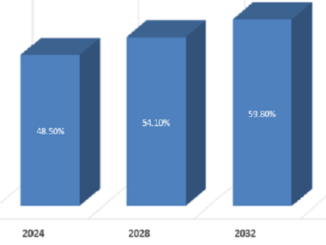
Much of California’s loss to Florida was offset by people coming the other way.
by Don Lee, Los Angeles Time
lorida Gov. Ron DeSantis delivered a well-rehearsed blast at California this week, calling it too left, too woke, too expensive.
And as proof, he declared, Californians and residents of other liberal states were leaving in droves for Florida.
“If you look over the last four years, we’ve witnessed a great American exodus from states governed by leftist politicians imposing leftist ideology and delivering poor results,” he said Sunday at the Ronald Reagan Presidential Library in Simi Valley.
Is what DeSantis said true? As the saying goes, “It’s complicated.”
Here are the best answers available to some of the most important questions about how many people are leaving California, who they are, where they’re going, and why.
Are people leaving California in greater numbers than those moving into the state?
Yes, for the first time in many years, California seems to be experiencing a net decline in total population.
The latest California Finance Department figures, which are for 2022, show the state’s population dropped by about 211,000 from 2021 out of a total population of 39 million. That was partly because foreign immigration into California remained at relatively low levels and didn’t offset the decline in domestic net migration.
Still, as a percentage of the total population, the out-migration to other states is relatively small.
Are more Californians pulling up stakes and heading for the Sunshine State?
Yes, but the numbers should be looked at in context.
After mostly steady annual outflows from California to Florida in the prior decade, the numbers jumped 22% in 2020, according to the most recent available figures from the Internal Revenue Service.
Figures from other sources confirm that the pace of Californians heading to Florida, along with some other states, has picked up significantly since the pandemic.
The number of California driver’s licenses turned over to Florida were up more than 50% in 2021 and 2022 compared with the average of the prior five years.
But bear in mind that the actual number of individuals involved is tiny as a share of California’s overall population.
The total of all those moving from California to Florida amounted to 29,000 people, based on changes in driver’s licenses. IRS data suggests the total might be a few thousand more.
“It’s still a fairly small number,” said University of Florida demographer Stefan Rayer.
To put it in numerical terms, it’s not even one-tenth of 1% of California’s population of 39 million. The numbers are similarly miniscule as a share of Florida’s population of 22.2 million.
Is the migration a one-way street, or is there movement from Florida to California?
It’s not one way. Much of California’s loss to Florida was offset by people coming the other way.
For every six Californians who left for Florida last year, five moved into the state from Florida, according to data from Moody’s Analytics and the credit firm Equifax.
Who is leaving the state for Florida?
All across the country, not just in California or Florida, Americans who move from one state to another tend to be on the younger side: in their 20s and 30s.
When it comes to Florida, that pattern does not hold, at least not for California.
Almost one-third of Californians who moved to Florida were 50 years or older, compared with about 20% for those moving to all other states, according to Census Bureau data analyzed by Brookings Institution demographer William Frey.
In that regard, older Californians are just following an old and well-trodden path: With its low sales tax and no state personal income tax, cheaper housing and all-around lower cost of living, Florida has been a magnet for older Americans going back a century or more. It has long had appeal to those on fixed incomes since pensions and savings go further there.
Are high-earning, educated Californians moving to Florida?
No one has definitive statistics breaking down jobs and median incomes of those leaving, but studies by the Public Policy Institute of California have shown that, in general, people moving out of the state tend to have lower education and incomes than people coming into California.
In hard-nosed economic terms, that’s a net plus for California.
The situation is a little more complicated when it comes to Florida.
Being older and having more established backgrounds, about half of the California migrants to Florida have college degrees and on average are likely to have relatively higher incomes than those moving to some other states.
But economically speaking, older migrants’ most productive years are usually behind them. So when it comes to Florida, which tends to attract these older people, the loss of education and incomes tends to be less painful for California.
What are other reasons Californians are moving to Florida?
Except for retirees looking to stretch their budgets, the answer is probably not much different from what drives people to move across state lines everywhere.
Jobs, whether a transfer or a new one, are the No. 1 reason people make interstate moves, according to 2022 census survey data.
Second are family considerations, such as a change in marital status or to be closer to other family members.
After that comes housing-related issues — wanting to own a home or find cheaper housing.
Those three factors account for about 85% of the why-move answer from people nationally.
Remote work also may be adding some juice to migration, he said.
California’s median sale price for a single-family house was $751,330 in January, almost double what it was in Florida.
“It’s simply housing,” said Wendell Cox, a principal at Demographia, a public policy consultant in Illinois, of the increase in out-migration.
“California housing costs are so out of line with the rest of the nation and with what they were historically that middle -income folks can’t afford to live there.”
What about political ideology and liberal policies, which DeSantis says is the driving force?
It’s hard to say for sure.
Surveys asking Californians whether they want to leave the state have found a huge partisan divide, with Republicans overwhelmingly saying they’re interested while Democrats mostly say the opposite.
And those feelings may play a part in some people pulling up stakes, says Eric McGhee, a senior fellow at the Public Policy Institute of California.
But saying you’re interested in moving as a theoretical question and actually pulling up stakes and leaving are very different matters.
McGhee and many others at all points on the political spectrum say most people move for basic economic reasons.
“The motivation to buy a home somewhere is not based on wokeness,” said G.U. Krueger, a longtime housing economist in Los Angeles who has done work for the California Public Employees’ Retirement System, the nation’s largest state pension fund. “It’s about the life stage people are in — and wokeness is not a stage of the life cycle.”
Is there an ethnic or racial aspect to this issue?
Non-Hispanic whites have left California for other states in disproportionately large numbers, and that’s particularly so for Florida.
So although whites comprise just 35% of California’s population, they accounted for 59% of those who have moved to Florida in recent years, according to census data tabulated by Frey.
The same data show Florida has considerably less appeal to California’s Blacks and Asians than other states as a whole.
So what does the future hold in the California-Florida battle?
Florida is likely to continue to draw older people and retirees, but just how much it will attract others will depend on what happens with housing prices and economic growth in both states.
“What’s new is that Florida has emerged as an alternative for industries that have historically been big in California,” said Joel Kotkin, a fellow at Chapman University who has written widely on California demographic, social and economic trends.
That includes tech and the commercial space industry, he said, and expansion of its ports. Inflows of venture capital will help Florida keep growing. Last December, Florida announced $2 billion in investments from asset manager BlackRock.
To some extent, this is a pattern in many parts of the country. At least in part, that’s because, as tech-related industries have evolved and matured — sprouting an endless variety of new goods and services — it’s no longer necessary for every enterprise to be located in the cities and states where it all began.
Still, few people anticipate a rush of Californians heading to Florida. There are plenty of other alternatives a lot closer, particularly Texas, Arizona and Nevada, which have long been the top three destinations for Californians.
Besides, Kotkin said, “Californians never had the motivation to move to Florida for the weather.”
Don Lee covers the U.S. and global economy out of Washington, D.C. Since joining the Los Angeles Times in 1992, he has served as the Shanghai bureau chief and in various editing and reporting roles in California.



